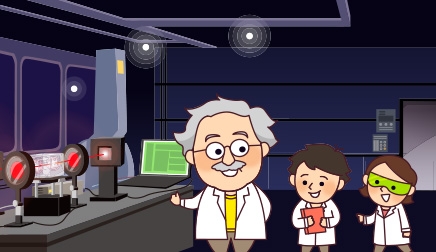 Home > Professor lights > Vol.03 Yoshiaki KATO
Home > Professor lights > Vol.03 Yoshiaki KATO
Vol.03 Yoshiaki KATO
Half a century with lasers — from researcher to leader

Yoshiaki Kato
President of The Graduate School for the Creation of New Photonics Industries
President of The Laser Society of Japan
Profile In 1965 he graduated from the Department of Applied Physics, Faculty of Engineering, the University of Tokyo, and in 1970 he completed his doctoral course also in the Department of Applied Physics at the Graduate School of Engineering of the same university. In May 1983 he was appointed to a professor at the Institute of Laser Engineering, Osaka University. In October 2007 he became a professor at The Graduate School for the Creation of New Photonics Industries (GPI). In April 2009 he was elected to the president of GPI and currently still holds that position. He is also a professor emeritus at Osaka University, a Fellow of The American Physical Society, and the Program Director of Photon Frontier Network Program under MEXT (The Ministry of Science, Education, Culture, Sports, Science and Technology-Japan (from 2008 to present).
During his childhood, he spent most of his time running around outdoors. He later found out about the laser which had just been invented and has since been deeply involved in its development. Yoshiaki Kato, now president of The Graduate School for the Creation of New Photonics Industries, has been engaged in the development of lasers in Japan from the early days to the present, while finding out new roads which opened up gradually during the changes of the era and encounters with people. In Vol. 3 of Professor Lights, we asked him how he has been involved in light and lasers for a period spanning half a century.
It all began with encounter with quantum electronics
Days of non-stop research spent in a locked up school
Transferring to the University of Toronto and missing the first by a hair
Working on laser fusion and changing the position from a researcher to a project manager
Fostering talent to support laser technology and its future progress
It all began with encounter with quantum electronics
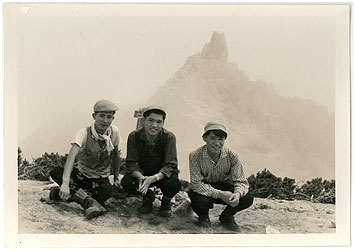
(Kato is in the center)
President Kato was a sports-loving young boy. He did not spend time studying quietly in elementary and junior high schools, but played sports outside every day. The reason he chose science at high school was that he was not enthusiastic about memorizing various names and years but did enjoy solving problems. His first encounter with lasers was upon entering his fourth year of college. Most of his classmates picked the then popular field of semiconductors as the research topic for their graduation thesis, but Kato found he was too late to ride the semiconductor boom since he says, “I was in a university soccer club and its practice and games kept me busy day in and day out, so I couldn’t talk with my classmates often.” He also says that this led him to choose the field of lasers which was still in its infancy.
Thinking back on those days, he says, “There was a research theme given the name of quantum electronics. It was the first time I had ever heard this word, and I wondered what the name actually meant.” The time was 1963 and the laser, an artificially made light, had just been invented in 1960, so only 3 years had passed up to that point. “When I first heard my research lab professor talk about lasers, I remember thinking, “Wow this sounds great!” But I didn’t even think for a moment that lasers would become my life’s work. People involved with ongoing laser research talked about its wonderful possibilities, but lasers were still unknown by most people and I didn’t have any particular vision for the future about it,” he adds with a chuckle.
However, research on lasers then took off at lightning speed, spreading not only to the scientific and academic fields but also establishing a business base for itself. In the 1960s through 1970s the main laser application was high-precision measurement. New inventions and applications appeared one after another such as pulsed lasers that could capture instantaneous phenomenon and nonlinear optics capable of using lasers to generate phenomena not likely to occur in a normal state.
Kato had chosen the “ruby laser” as the theme for his graduate study and master’s degree program, and then when he proceeded onto the doctor’s course, he decided to continue his studies in the field of “Raman spectroscopy” which utilizes a gas laser to perform chemical analysis. When a liquid is irradiated with light, it produces light at a wavelength slightly different from the irradiation light. Analyzing that resulting light reveals the composition of the liquid. Before the laser appeared, mercury lamps were utilized as light sources for Raman spectroscopy measurement. However, when the switchover to lasers was made, measurements that once took several days could now be made in just a few minutes. So, laser Raman spectroscopy was rapidly put to practical use.
Days of non-stop research spent in a locked up school
Those were the days of violent student protests at universities. Boards were nailed across the entrances to classrooms and building barricaded making it impossible to hold classes and the entire university was a place of noise and confusion. Our thesis advisors spent almost all their time trying to deal with students and did not have time to appear at the research labs. “We realized that we actually had to proceed with research by ourselves, but it was not bad for fostering our independence,” he comments. We spent our time reading overseas and domestic journals that reached the library and brought books to the research labs and held roundtable discussions about them. “There were seniors at our research lab who were extremely devoted to the research and brought us books not only about lasers but also on other related subjects. These gave us a wide ranging basic knowledge of quantum electromagnetics, nonlinear optics, condensed matter physics, and so on. So we really appreciated this chance,” he adds with a smile.
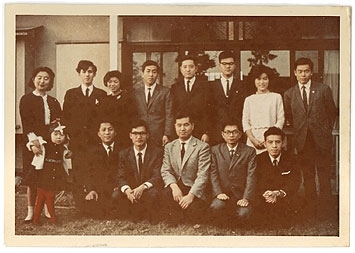
(Prof. Hiroshi Takuma, his teaching adviser is in the front row center, and Kato is on his left)
The theme “Absolute Measurement of Raman Scattering Cross Sections” that Kato worked on for his doctoral thesis required a lot of patience. “To establish a method for quantitative analysis by Raman scattering, we had conducted research by irradiating laser light onto a liquid, spectrally dispersing the resultant scattered light, and measuring the absolute value of the intensity of the scattering light. The intensity of the scattered light is about 10 orders of magnitude weaker than the input laser light irradiating the liquid. It is possible to determine the intensity of this extremely weak light by comparing it with an “intensity standard” based on black body radiation. To obtain the black body radiation that serves as an international standard, we started with making a black body furnace on our own and without using commercially available standard lamps known to have a larger error factor,” says Kato. At that time there were a lot of people working on Raman scattering research, but no one knew about “scattering cross-sections of molecules (or fraction of the scattered light relative to the incident light by Raman scattering with molecules)” so no one was using Raman scattering for quantitative analysis. The black body furnace is a high temperature furnace and must be kept continuously over several weeks once set to a stable fixed state. It must be maintained at a fixed temperature of approximately 900°C, so I could not leave it and go home. I had to stay overnights in the research lab and the experiment continued for long periods at a time. Finding “absolute values” which anyone can utilize as standard values required attention to the smallest details. This research helped me establish a strong foundation in physics research, and this research publication was later cited by many persons.
Transferring to the University of Toronto and missing the first by a hair
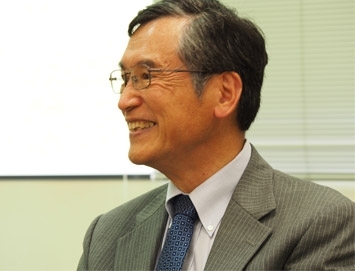
Japan achieved amazingly high-level economic growth in the period from the 1960’s to early 1970’s. But along with this growth, pollution problems began to emerge. At around that time, when the laser was starting to gather attention for its measurement capabilities in order to know the actual levels of water pollution and air pollution, Kato decided to embark in a new direction. He transferred to the University of Toronto (UoT) in Canada. His research in Raman spectroscopy had been highly rated and he was getting invitations to work at overseas institutions.
At Toronto he started working on utilizing Brillouin scattering to measure lattice vibration by light scattering. “However, just that alone would not be interesting enough,” he says, “so using my own ideas I thought up different methods for improving the spectral resolution in laser spectroscopy. Those efforts led to obtaining a high resolution spectrum through light absorption rather than light scattering. He comments, “The Doppler effect accompanied with the thermal motion of atoms or molecules is the main factor in broadening the spectral width in either light scattering or light absorption. So I considered using two-photon absorption as a method to cancel out this Doppler effect.”
Achieving this method required a new type of laser capable of changing its wavelength, but the research lab at that time only had fixed frequency lasers so experiments were at a dead end.
“While we were doing all these things, Stanford University that possessed the new type laser tested this method and got the jump on us.” Not much later his lab at UoT also started using the new laser and, though one step after Stanford, we succeeded in utilizing this method to obtain the high resolution spectrum of an atom in a highly excited state (Rydberg state). So we had missed the first place in this research just by a hairsbreadth. Yet now looking back on those days, Kato surprisingly does not feel any regret about this. He had found out for himself that “there are always two people in this world who are thinking exactly the same thing.” The research on the Rydberg state later on became an important theme in our research lab. “So I feel I was able to return for the kindness of the University of Toronto for my stay,” he says as always showing the spirit of a dispassionate researcher. What is important is whether the research results have an impact in the world or not. Rather than winning or losing, Kato pours all his efforts into getting results that exceed expectations in the scientific realm, giving us a glimpse of his personal philosophy about life.
Working on laser fusion and changing the position from a researcher to a project manager
In 1973 and again in 1978, Japan was twice subjected to the pain of an oil shock. Japan is a country with little resources. So, the concept of “laser fusion” (nuclear fusion with lasers) offers the hope of extracting endless amounts of energy from seawater. In 1975, in his third year in Toronto, Kato was invited to work at Osaka University which at that time held a leading role in laser fusion research. This opened him the door again to a new career opportunity with laser research. However, he slightly hesitated about whether to take on this new work. More specifically, the laser fusion research at Osaka University involved research that utilizes an extremely high-power laser. “This was a completely different world from the high-resolution, high-precision spectroscopy I had worked on up to that time and I had no idea how to go about doing this work,” he says. Even so, he soon decided to take up the challenge of this new mission.
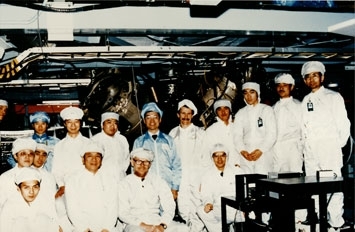
(Kato is in the rear row center.)
At Osaka University he encountered a further unexpected development. At that time, the “Gekko I” laser had been built as the major facility for laser fusion. However, there was also a plan for developing a “Gekko IV” laser capable of emitting an even more energetic laser beam. Kato had just taken up his post there, and was given the job of project manager for developing this “Gekko IV.” Until then his role had been that of a researcher but now he was suddenly a project manager. Faced with this drastic change toward playing a new role, he again felt hesitant.
“Until then, in my role as a researcher, all I had to do was use the equipment to perform just my own research. However, managing the project meant I was required to decide schedules and project steps and everyone’s particular job. Up to then I had never played what they call a management role, I did not have a good idea how to go about it and felt anxiety,” he says. Moreover, “the management of a project is hard to define in an academic paper. I had to get rid of my researcher type motivation for the pursuit of originality. This new job required a complete mental changeover,” he comments looking back on that period.
This laser fusion development project involved a large number of people including those from many companies as well as researchers and engineers. How should he go about efficiently managing the schedule and budget of a project that involved so many different types of people? Kato decided to apply a project management method that was then starting to circulate throughout Japan. He also added new elements to the development itself. He decided to employ phosphate laser glass, which was still in the prototype stage, as the glass used in the glass lasers. This decision turned out to be very successful, obtaining a laser output which was more than twice that of the large lasers of the same scale in the US and France, and later on all of the world’s large-size lasers started using phosphate laser glass. Kato also came up with a plan for a “random phase method” to uniformly irradiate the nuclear fusion target. Applying this method contributed to generating the world’s highest yield of neutrons via a nuclear fusion reaction with the Gekko XII facility. Over a total period of 8 years, Kato managed the project development of three large-size laser fusion facilities. Though still sad about having to abandon his role as a researcher, he moved ahead with the projects while continually applying new ideas, pouring all his efforts into achieving the mission of making laser fusion a reality.
Fostering talent to support laser technology and its future progress
Currently Kato plays three major roles. The first role is a Program Director of the “Photon Frontier Network” under the Ministry of Education (MEXT). This program focuses on fostering talented young researchers together with embarking on innovative laser research, by forming the consortiums composed of major Japanese laser researchers throughout the Kanto and Kansai areas. A second role is the president of the Laser Society of Japan (LSJ). The Laser Society of Japan has a more than 40-year history and approximately 40% of its participating members belong to companies in this field. LSJ promotes both laser research and industrial developments, by linking the academic and the industrial communities. A third role is the president of The Graduate School for the Creation of New Photonics Industries (GPI). Here his task is to assist students, mostly working at companies or by themselves, aiming at creating startup businesses or new enterprises in the field of photonics. These three roles place him at a position to get involved in activities widely ranging from academic to industrial fields, with the scope to further evolve photonics and lasers toward contributing to our livelihoods and industries more deeply. Among these roles, we asked him about his views on fostering human talent in photonics based on his position as president of GPI which is deeply involved with ongoing work at Hamamatsu Photonics. He comments:
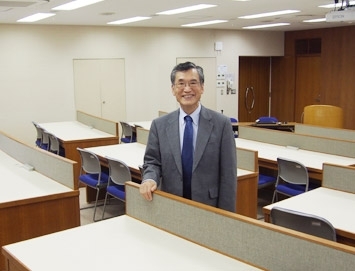
“GPI has the goal of fostering those who can create and promote new business enterprises. When working on something new within a company or trying to startup a new enterprise, it is sometimes difficult to achieve a breakthrough just by working within the established organization or boundaries. In such cases, our school can help overcome the difficulties. GPI offers close support to individual student for helping them think over the existing ideas and take actions by themselves in order to achieve technical innovation and business startups. This point is what makes GPI different from similar institutions in Japan.”
Recently, it appears that there is a drop in the reputation of Japanese technical capability and other countries are catching up with Japan. So we asked how Kato feels it and what can be expected from photonics technology for Japan’s future. He replies:
“The percentage taken up by photonics among science and engineering as a whole may appear small. But in fact photonics is already employed in nearly all fields, and photonics science and technology is advancing with tremendous speed in Japan and worldwide.
Photonics alone will not solve all of our problems but it has become a key technology indispensable for resolving various issues that cannot be dealt with by other methods. Such kinds of cases will become even more numerous in future years. What Japan has at present are cutting edge R&D, technical precision and thoroughness, and reliability in product quality and business. Upon these strong bases, we have to further create innovative technology and concepts with high added values applicable worldwide in coming years. If we can continue to implement industrialization of these ideas and technology, then I believe there will be plenty of opportunities for us to take leading roles in the world.”
●
To President Kato who since his early twenties has spent nearly a half-century continually involved with lasers, the laser itself represents “an enjoyable friend.” The more he becomes involved with it, the more diverse the aspects that appear and it takes on the role of a lifetime partner that grows and expands in a variety of ways. While riding out the different changes occurring over time and changing the position from researcher to administrator, and moreover to a leader, he pours his total efforts into what he sees as his own mission and gives it his best effort. That fighting spirit seems to be still alive beneath a calm way of talking. After interviewing president Kato, we get the impression that he always takes a good look at the reality to support and encourage those who take on roles in laser technology and its progress.




